See Through The Film: Dennis Allen
Two seasons into his stint as the head coach of the Oakland Raiders, Dennis Allen finds himself on the hot seat. A failure to show promise this year will almost certainly mean that Allen will serve as a coordinator in some other city next year. However, after being ranked dead last in NFL.com's coaches' power rankings, I wondered if the Raiders' recent failures are more at the fault of Allen's coaching or GM Reggie McKenzie and the front office's shortcomings of putting the right talent on the field. It's impossible to know every detail of how the defensive-minded Allen coaches his team, but a large part of determining his worth is the way in which he calls plays for his defense. After further analysis, here is what I saw from Allen's defense:
Week 2: Raiders at Jaguars
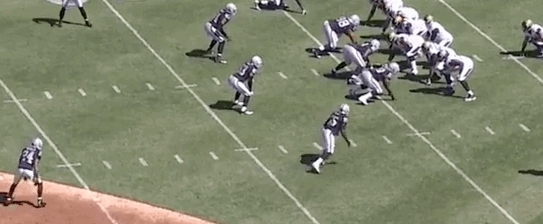
6:13 A late shift by the defense, and the Jaguars don’t account for an extra man at the line of scrimmage. The extra defender chases down the run play from the back side and makes the tackle for a loss.

8:15 Another late shift puts “Robber” Woodson in position to make a play on the crossing route for a minimal gain.
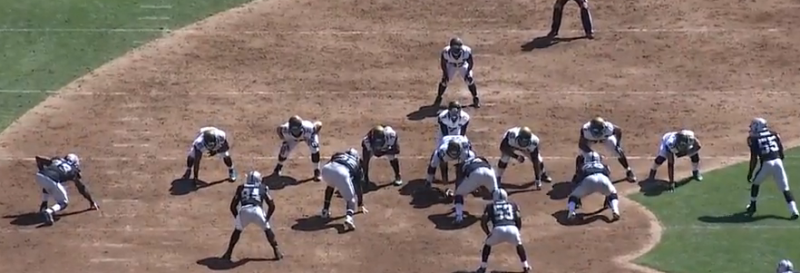
Allen used a “Bear” front quite often in this game, in which three defensive linemen line up over both guards and the center. This is used to pack the line of scrimmage, pack running lanes, and stop the run more effectively, therefore forcing the offense to put the ball in the hands of their quarterback.

45:10 Allen blitzed early and often in this game. He was able to do so successfully for the most part because the Jaguars didn’t have the playmakers on offense to make the Raiders consistently pay for playing so much one-on-one coverage behind their blitzes. For instance, on this play, Henne checks the ball down to a short-crossing receiver who is tackled by Charles Woodson for a minimal gain. He potentially had his tight end at the top of the screen who had position on his defender for a deep ball, but Henne for whatever reason doesn’t pull the trigger. Therefore, while many of Allen’s schemes worked against Jacksonville, I get the sense that against more potent offenses they won’t be nearly as effective.
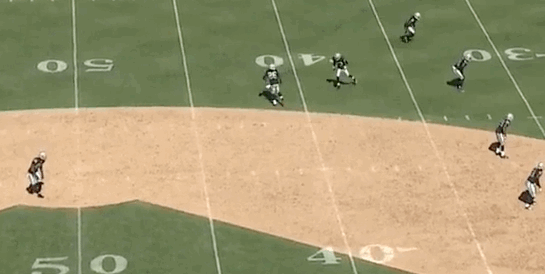
45:40 Allen uses another late shift to disguise the coverage on a third-and-long. The defense starts out with a man-coverage, single-high look, then shifts late and actually runs a three-deep, five-under zone designed to take away the deep ball and force an underneath pass. As you can see, this defense works to perfection as Henne is forced to check it down, failing to convert.
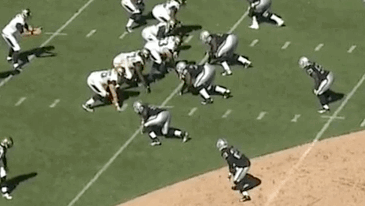
54:57 The fact that Allen’s defense often doesn’t show its hand until just before the snap not only serves to confuse the quarterback on passing plays, but also on running plays. When quarterbacks can read the blitz well before the snap, they can audible into a call conducive to beating the blitz. However, when they don’t know the pressure is coming and a run play is called, like this one, the defense is able to stuff the run relatively easily while making it initially look like they’re playing the pass.
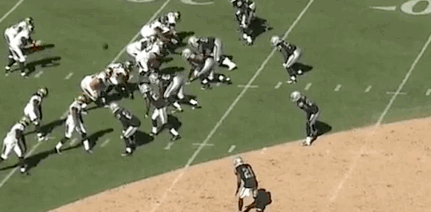
1:02:15 The Raiders’ blitz works to perfection here, but the Jaguars look woefully unprepared for it. All of Jacksonville’s receivers run routes that are relatively easy to guard, mostly in one area of the field, and there doesn’t appear to be a “hot route” option for Henne to quickly throw the ball to in the event of a blitz like this. Against more prepared teams, Oakland could very well get burned on blitzes like these.
Week 3: Raiders at Broncos
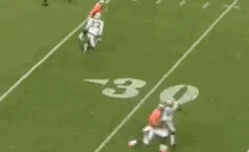
31:43 Here is a prime example of a better offense taking advantage of Oakland blitzing. Peyton Manning gets the ball out in a timely manner to Eric Decker, guarded in one-on-one coverage, who proceeds to take it 61 yards.
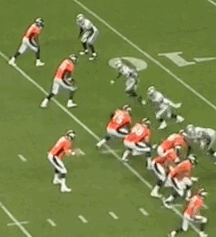
33:20 The Broncos are perfectly prepared for this blitz, and Manning easily gets the ball to his hot receiver in the flat for a completion that ends up being a touchdown. Allen’s aggressiveness is again taken advantage of by a superior offense.
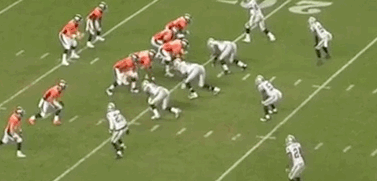
53:40 I didn’t notice any significant breakdowns in the Raiders’ defense in this game, but the Broncos’ execution and playcalls were simply superior to most of what Oakland threw at them. For example, Oakland appears to be playing cover-three with zone coverage underneath here. The Broncos, however, have the perfect playcall to combat this defense. Denver calls what appears to be a levels concept run by Welker and Decker, with Welker’s route going underneath and Decker’s a few yards deeper downfield. Welker draws the underneath zone coverage forward with his presence, allowing Decker to settle down right behind the zone coverage in an open space where Manning hits him for the first down. There’s nothing Oakland can do to stop this play when they’re in zone defense, because covering Decker further downfield would have resulted in a wide-open Welker underneath.
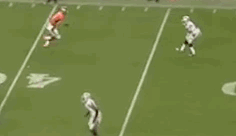
Here is a big issue I had with Allen’s defense in this game—Denver repeatedly ran quick “in” routes like this with their receivers with great success. I saw no adjustment by Oakland to play press coverage or anything of the sort to stop what seemed to be an automatic 6-10 yard gain every time. Instead, Oakland consistently played off-coverage and allowed this play to be completed on a consistent basis.
Week 6: Raiders at Chiefs
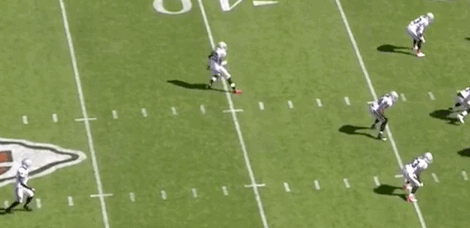
7:00 The Raiders start out with a single-high, man coverage look. At the snap, however, the safeties rotate into a two-deep look and the defense looks like it’s playing cover-2 with zone coverage underneath. This unexpected, disguised defensive shift throws Alex Smith off and he is forced to throw it away as all of his receivers are covered.
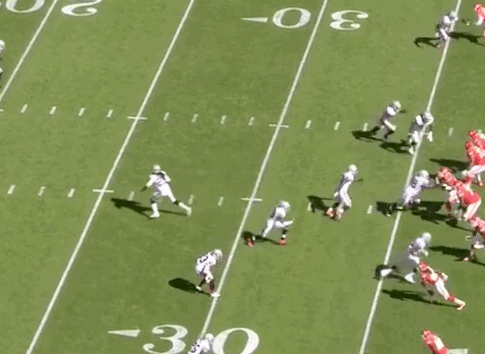
15:00 Here’s another original blitz by Dennis Allen. The safeties again do a nice job of disguising their coverage. The Chiefs are woefully unprepared for it as all of the receivers run relatively slow-developing routes that don’t give Alex Smith a quick option to go to. The routes of the two receivers on the bottom of the screen are too close together in this situation, which enables the deep safety to play over the top of both of them early in the play—this is all the time the blitz needs to get to Smith. With better route designs, the receivers (especially the one vacated by the blitzing cornerback at the top of the screen) had one-on-one opportunities and room for big plays. Against a better offense, I’d be willing to bet that this blitz wouldn’t be as successful.
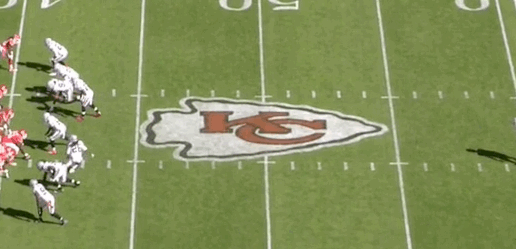
22:35 Here’s another blitz with disguised coverage behind it. The safety fakes pressure and then runs back to cover his deep half, while the cornerbacks provide man coverage underneath the two-deep shell. Meanwhile, the blitz brings an overload to the offensive left side, getting the quick pressure on Smith. This is a well-designed defensive call that should work even against some of the best offenses in the league because of the deep safety help that the cornerbacks receive, making their man coverage jobs easier.
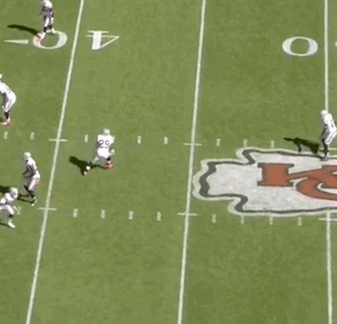
29:35 Oakland shows blitz, then drops out into a 3-deep, 5-under zone. There isn’t anywhere to throw the ball, and the Raiders again forces Kansas City to punt. Another effective disguise by Allen.
Week 13: Raiders at Cowboys
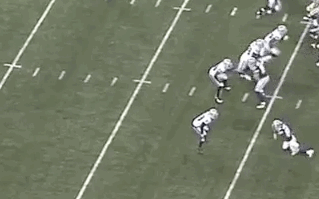
41:53 Again, here’s what often happens when you blitz and ask your cornerbacks to guard receivers one-on-one. Easy completion to Dez Bryant, and that’s the reality of what will happen even against defenses with good cornerbacks.
Week 16: Raiders at Chargers
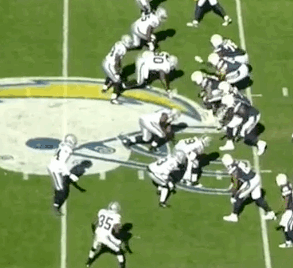
7:50 Ken Whisenhunt outduels Allen on this third down here. The Chargers motion into a bunch formation, the Raiders’ defensive backs get mixed up in their assignments, and a Chargers receiver breaks wide open over the middle for an easy first down. Man coverage is very difficult against a bunch formation simply because of the amount of traffic that comes with having so many people in such a small area. Additionally, Allen’s blitz is easily picked up by the offensive line. An all-around poor call in this situation.

25:30 Whisenhunt outsmarts Allen again on this third down with a perfectly executed cover-2 beater. Whisenhunt sends a tight end down the seam to keep the safety from coming over the top of the wide receiver; he also sends the wide receiver deep, so the safety essentially has to cover two people. The running back in the flat baits the cornerback into staying closer to the line of scrimmage so he can’t drop with the receiver. The Raiders play a fair amount of cover-2 with zone coverage underneath on third-and-long plays and in this instance, they were too predictable.
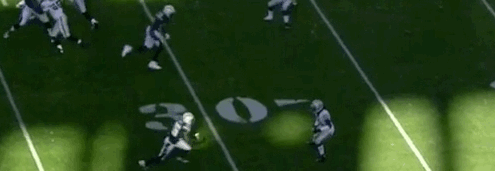
26:00 On the very next play, Allen gets his revenge. Whisenhunt calls a very similar concept, with both the tight end and the wide receiver running deep routes on the same side of the field. However. Whisenhunt apparently doesn’t anticipate another cover-2 call from Allen, and there is no running back sent into the flat to bait the cornerback. This allows Mike Jenkinks to trail his receiver downfield, and eventually come up with the interception. Good job by Allen for catching the Chargers off guard.
***
Allen's overall philosophy is, in theory to be a big-play, bend-but-don't-break defense. He blitzes A LOT, and often leaves his cornerbacks in one-on-one situations. The only problem with this is the fact that his defense does indeed have the potential to break when a defensive back makes one mistake or misses a tackle, and large gains by the offense unavoidably ensue. When you leave your defensive backs in single coverage as often as Allen does, your defense is bound to give up big plays and long touchdowns, no matter how talented you are--NFL offenses are simply too good and the rules are too in-favor of offenses for this not to happen.
While Allen's blitz-heavy defense was effective against poorer quality teams with inexperienced quarterbacks like Jacksonville, the moment the opposition got better and more prepared (see: Denver, San Diego) the defense couldn't hold up.
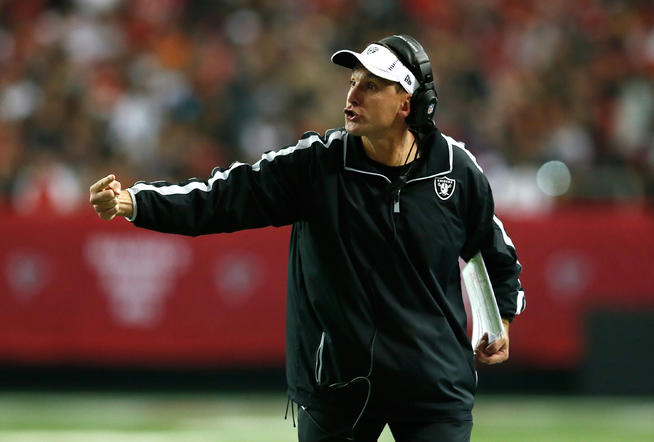
Last year's Raider defense actually wasn't completely decimated of talent, despite the perception many have of the Raiders. Defensive tackle Pat Sims is an above-average player who had a couple of stellar games, Lamarr Houston was a stud at defensive end, and the veteran secondary didn't appear to blow many coverages, although they were physically outmatched at times. Linebacker Nick Roach is also a good blitzer and tackler, in spite of what he lacks in coverage skills.
This coming year, however, the Raiders will have lost Houston and cornerbacks Mike Jenkins and Tracy Porter to free agency, while safety Charles Woodson is another year older. They'll hope that young cornerback DJ Hayden can take a step forward, but their secondary personnel doesn't exactly look favorable for Allen's blitz-heavy scheme.
One thing I will give Oakland credit for, however, is the improvement of their defensive line. They lost Houston, which I believe was a mistake, but they did add veterans Antonio Smith, Lamarr Woodley and Justin Tuck in free agency while drafting Khalil Mack in an overall upgrade of their front-seven. This, combined with the weakened secondary, makes me think that Allen will change his defensive philosophy this upcoming season and play heavier coverage while relying more on his defensive front to create pressure for opposing quarterbacks. After all, great coaches tailor their schemes to fit their personnel, not vice-versa.
Next year will be a test of Allen's ability to adapt to his personnel and common sense in general--an NFL football team simply can't have sustained winning bringing seven-man pressure every play on a consistent basis, especially if they have an offense that can't score points themselves.
In a few months, we will see Allen's true colors. For his sake, hopefully they are silver and black.
You can reach Andrew McKagan here.



